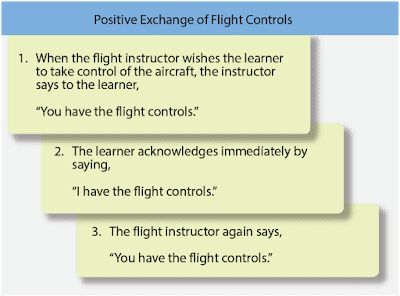Positive exchange of flight controls is an integral part of flight training. It is especially critical during the demonstration-performance method of flight instruction. Due to the importance of this subject, the following discussion provides guidance on the recommended procedure to use for the positive exchange of flight controls between pilots when operating an aircraft.
Background
Incident/accident statistics indicate a need to place additional emphasis on the exchange of control of an aircraft by pilots. Numerous accidents have occurred due to a lack of communication or misunderstanding regarding who had actual control of the aircraft, particularly between learners and flight instructors. Establishing the following procedure during initial training will ensure the formation of a habit pattern that should stay with learners throughout their flying careers.
Procedure
During flight training, there should always be a clear understanding between learners and flight instructors about who has control of the aircraft. The preflight briefing should include procedures for the exchange of flight controls. A positive three-step process in the exchange of flight controls between pilots is a proven procedure and one that is strongly recommended. When an instructor is teaching a maneuver to a learner, the instructor normally demonstrates the maneuver first, then has the learner follow along on the controls during a demonstration and, finally, the learner performs the maneuver with the instructor following along on the controls. [Figure]
 |
| During this procedure, a visual check is recommended to see that the other person actually has the flight controls. When returning the controls to the instructor, the learner should follow the same procedure the instructor used when giving control to the learner. The learner should stay on the controls and keep flying the aircraft until the instructor says, “I have the flight controls.” There should never be any doubt about who is flying the aircraft |
Flight instructors should always guard the controls and be prepared to take control of the aircraft. When necessary, the instructor should take the controls and calmly announce, “I have the flight controls.” If an instructor allows a learner to remain on the controls, the instructor may not have full and effective control of the aircraft. Anxious learners can be incredibly strong and usually exhibit reactions inappropriate to the situation. If a recovery is necessary, there is absolutely nothing to be gained by having the learner on the controls and having to fight for control of the aircraft. Learners should never be allowed to exceed the flight instructor’s limits. Flight instructors should not exceed their own ability to perceive a problem, decide upon a course of action, and physically react within their ability to fly the aircraft.
